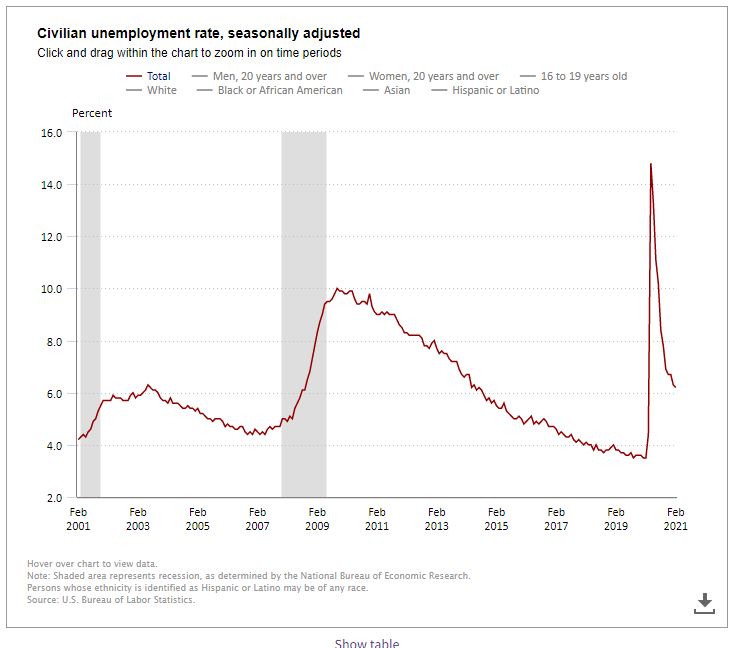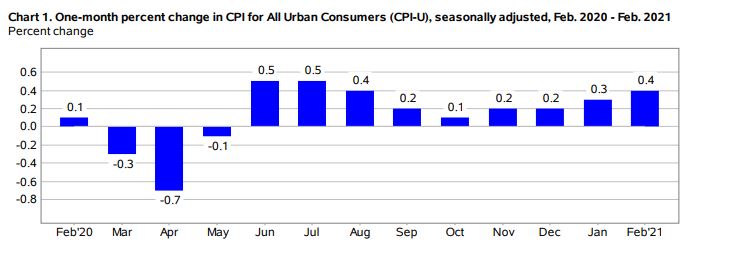Employment Blog March 2021
This employment blog is taken from the U S Department of Labor, Bureau of Labor Statistics. Nonfarm payroll employment rose by 379,000 in February, and the unemployment rate was little changed at 6.2 percent. The labor market continued to reflect the impact of the coronavirus (COVID-19) pandemic. Employment rose sharply in leisure and hospitality. Notable job gains also occurred in temporary help services, health care and social assistance, retail trade, and manufacturing. State and local government education, construction, and mining lost jobs over the month. Substantial job losses related to the coronavirus pandemic first occurred in March (-1.7 million) and April (-20.7 million) of 2020. As economic activity resumed, employment increased by 12.6 million from May through November but declined again in December (-306,000) following a surge in the number of coronavirus cases. Nonfarm payroll employment has increased by 545,000 over the past 2 months but is down by 9.5 million, or 6.2 percent, from a year ago.


Leisure and hospitality gained 355,000 jobs in February, as pandemic-related restrictions eased in some parts of the country. This followed job losses of 523,000 in December and January combined. Within the industry, job growth in food services and drinking places (+286,000) accounted for about four-fifths of the February increase. Employment also rose in accommodation (+36,000) and in amusements, gambling, and recreation (+33,000). Employment in leisure and hospitality is down by 3.5 million, or 20.4 percent, from a year ago.
Within professional and business services, employment increased by 53,000 in temporary help services in February but is 175,000 lower than a year ago. In February, employment in health care and social assistance rose by 46,000. Social assistance added 26,000 jobs over the month, with most of the gain in individual and family services (+18,000). Employment in social assistance is 331,000 lower than a year ago.
Health care employment changed little in February (+20,000), following a large decline in the prior month (-85,000). In February, ambulatory health care services added 29,000 jobs, while nursing care facilities continued to lose jobs (-12,000). Health care employment is 578,000 lower than a year earlier.
Retail trade employment rose by 41,000 in February. Job gains in the industry were widespread, with the largest gains occurring in general merchandise stores (+14,000), health and personal care stores (+12,000), and food and beverage stores (+10,000). These gains were partially offset by an employment decline in clothing and accessories stores (-20,000). Following steep job losses in March and April of 2020 (-2.4 million jobs over the 2 months combined), retail trade has added 2.0 million jobs from May through February.
Employment in manufacturing rose by 21,000 over the month, with about half of the job gain occurring in transportation equipment (+10,000). Manufacturing employment is down by 561,000 over the year.
In February, employment declined in both local government education (-37,000) and state government education (-32,000). These declines partially offset increases in January. Private education employment was little changed over the month (-2,000). Pandemic-related employment declines in 2020 distorted the normal seasonal buildup and layoff patterns in the education sector, making it more challenging to discern the current employment trends in these industries. However, employment is down over the year in local government education (-674,000), state government education (-327,000), and private education (-390,000).
Construction employment decreased by 61,000 in February, with job losses in nonresidential specialty trade contractors (-37,000) and in heavy and civil engineering construction (-21,000). Severe winter weather across much of the country may have held down employment and hours in the construction industry. Employment in construction is down by 308,000 over the year.
In February, mining shed 8,000 jobs, with losses occurring in support activities for mining (-6,000) and in oil and gas extraction (-2,000). Mining employment is down by 153,000 since an employment peak in January 2019, though nearly two-thirds of the decline has occurred over the past 12 months.
Employment in other major industries–including wholesale trade, transportation and warehousing, information, financial activities, and other services–showed little change over the month.
The Consumer Price Index for All Urban Consumers (CPI-U) increased 0.4 percent in February on a seasonally adjusted basis after rising 0.3 percent in January, the U.S. Bureau of Labor Statistics reported today. Over the last 12 months, the all items index increased 1.7 percent before seasonal adjustment.

